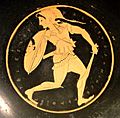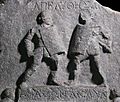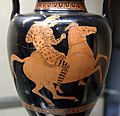Amazons facts for kids
- For other uses, see Amazon
In Greek mythology, the Amazons were a tribe of strong warrior women. People believed they lived in a place called Asia Minor.
Some ancient writers, like Apollonius of Rhodes, said the Amazons were the daughters of Ares, the god of war, and a nymph named Harmonia. They were known for being fierce and brave, and their main focus in life was fighting in wars.
Contents
Where Did the Amazons Live?
Ancient historians like Herodotus and Strabo thought the Amazons lived near the Thermodon River. Another writer, Diodorus Siculus, said they lived in Ancient Libya a long time before moving to the Thermodon area. From Libya, they traveled through Egypt and Syria, settling near the Caïcus river in a region called Aeolis. There, they founded several cities.
Later, Diodorus said they built the city of Mytilene. The writer Aeschylus believed their first home was near the Lake Maeotis, and from there, they moved to Themiscyra on the Thermodon. Homer, another famous ancient writer, mentioned that the Amazons were found somewhere near Lycia.
Famous Amazon Queens and Their Battles
Two very famous Amazon queens were Penthesilea and her sister Hippolyta.
- Penthesilea was a brave warrior who fought in the Trojan War. She sided with the city of Troy against the Greeks.
- Hippolyta had a special magical belt given to her by her father, Ares. This belt was so famous that getting it was one of the difficult tasks, or "labours," given to the hero Heracles.
Did Amazons Really Exist?
While the Amazons are part of mythology, some discoveries suggest there might be a real-world inspiration for their stories. Archaeologists have found burial sites on the Eurasian Steppes that contain the remains of female warriors. These findings suggest that women from the Scythian culture might have been the inspiration for the Amazon myth.
Since the early modern period, the name "Amazon" has been used to describe any female warrior.
What Else Did Amazons Do?
Legends say that the Amazons founded many important cities and temples. Some of these cities include Smyrna, Sinope, Cyme, Ephesus, and Amastris. It's also said that the Amazons were the first to invent the cavalry, which means fighting on horseback.
Amazon Traces in History
According to ancient sources, tombs of Amazons were often found across the ancient Greek world. Some were located in places like Megara, Athens, and Thessaly. Statues of Amazons were also common throughout Greece.
In modern-day Turkey, the city of Samsun has built an "Amazon Village" museum. This museum aims to teach people about the Amazons and attract tourists. Every year, a festival is held in the Terme district of Samsun Province to celebrate the Amazons.
In Greece today, female horse riders are sometimes called "Amazons."
Images for kids
-
Base of the Amazon Monument in the Amazon Park in the Atakum district of Samsun
-
A Greek fighting an Amazon. Detail from painted sarcophagus found in Italy, 350-325 BC
-
Departure of the Amazons, by Claude Deruet 1620, Metropolitan Museum of Art, New York
-
Battle of the Amazons, by Peter Paul Rubens, 1618, Alte Pinakothek, Munich
-
An amazon fighter statue in Terme, Turkey
-
A Tyrrhenian amphora, depicting an Amazonomachy - Hercules fights Andromache, Telamon fights Ainipe and Iphis fights Panariste, ca. 570 BC, Museum of Fine Arts, Boston
-
The Amazon Queen Thalestris in the camp of Alexander the Great, Johann Georg Platzer
-
A hippeis rider seizes a mounted Amazonian warrior armed with a labrys by her Phrygian cap. Roman mosaic emblema (marble and limestone) from Daphne, a suburb of Antioch-on-the-Orontes (now Antakya in Turkey), second half of the 4th century AD, the Louvre, Paris
-
Francisco de Orellana, coined the name Amazon River
See also
 In Spanish: Amazonas (mitología) para niños
In Spanish: Amazonas (mitología) para niños




















